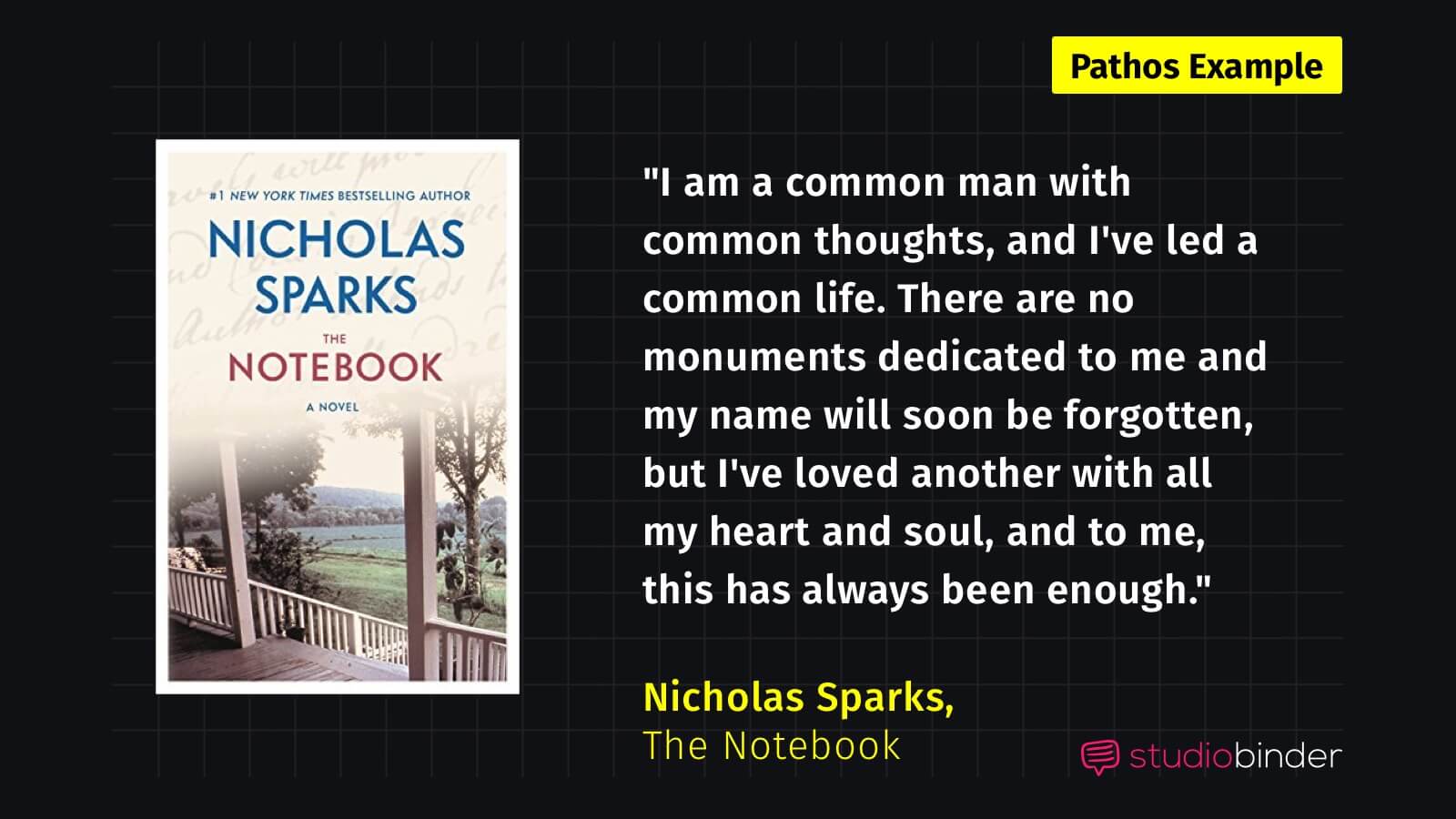Pathos is a mode of persuasion that appeals to emotion. Pathos has been used for thousands of years, and it is still used today to communicate “feeling.” We’re going to look at some pathos examples, but first, let’s look at what makes it different from the other rhetorical appeals: logos and ethos.
Pathos Examples
Logos vs pathos vs ethos
Aristotle outlined logos, pathos, and ethos as the three modes of persuasion in his book Rhetoric. These “rhetorical appeals” are used to appeal to logic, emotion, and credibility.
Writers and speakers use these “rhetorical appeals” to persuade people to their point of view. Now that we know what logos, pathos, and ethos are, let’s look at some pathos examples.
Pathos Examples Sentences
Pathos examples in literature
There are lots of examples of pathos in writing. Writers use pathos to communicate emotion in their characters and through the mood of their text(s).
Nicholas Sparks’s novel The Notebook is regarded as an “emotional” read by many; and it begins with a strong admission of pathos:

Pathos Examples in Literature • Pathos Example in The Notebook
Sparks uses repetition to highlight the “common nature” of his narrator. This allows him to emphasize the importance of the narrator’s love for his soulmate, which, despite not meriting monuments or a place in history, has “always been enough.” Emotional indeed.
However, not every emotional example is tear-jerking; other examples of pathos in writing instill terror instead. Take Fyodor Dostoevsky’s Crime and Punishment for example. In this excerpt, Raskolnikov has a horrifying emotional breakdown after committing murder.
"Fear gained more and more mastery over him, especially after this second, quite unexpected murder. He longed to run away from the place as fast as possible. And if at that moment he had been capable of seeing and reasoning more correctly, if he had been able to realise all the difficulties of his position, the hopelessness, the hideousness and the absurdity of it, if he could have understood how many obstacles and, perhaps, crimes he had still to overcome or to commit, to get out of that place and to make his way home, it is very possible that he would have flung up everything, and would have gone to give himself up, and not from fear, but from simple horror and loathing of what he had done.” – Fyodor Dostoevsky
Dostoevsky describes the loss of reason (logos) as a means to exacerbate the pathos of the scene. Raskolnikov is reeling from his crime; which is supported in the sentence structure and syntax. Fear can have strong emotional affect; proven succinctly by the paranoia seen here.
Related Posts
Pathos Commercial Examples
Pathos advertisement examples
Advertisers use pathos to get consumers emotionally invested in their brand(s). There are many different ways to go about using pathos in advertising, but one of the most surefire ways is a heartwarming story. This Budweiser ad is certainly a heartwarming story.
Pathos Examples • Heartwarming Budweiser Ad
Who doesn’t love clydesdales rescuing a puppy from a pack of wolves? Almost makes you want to crack open a cold one, right? Right?! Well, even if it doesn’t, it probably leaves you with a positive feeling on the brand; even if it’s only at a subconscious level. So the next time you see Budweiser, you’re reminded of a feel good story about dog and horse friends.
Public service announcements can also use pathos. For example: this anti drunk driving ad utilizes a “scared straight” approach.
Pathos Commercial Examples • Scared Straight Anti Drunk Driving PSA
This ad is meant to instill a sense of fear in people who consider driving under the influence. The pathos here is intimidating rather than heartwarming.
Related Posts
Pathos Examples
Pathos examples in music
Music is an emotional medium, so it makes sense that pathos would be something worth taking a look at. Of course, emotion can be communicated two ways in music: through the acoustics and the lyrics. We’re going to look at some examples of lyrics to see how songwriters communicate emotion.
“A CHANGE IS GONNA COME” BY SAM COOKE
“It's been too hard living, but I'm afraid to die. 'Cause I don't know what's up there, beyond the sky. It's been a long – a long time coming, but I know a change gon' come. Oh yes, it will.”
Sam Cooke’s “A Change is Gonna Come” is a great example of pathos in writing. The song tells the story of a person confronting hopelessness and expressing optimism for the future.
“YESTERDAY” BY ATMOSPHERE
“I thought I saw you yesterday but I didn't stop 'cause you was walkin' the opposite way. I guess I coulda shouted out your name, but even if it was you, I don't know what I would say. We could sit and reminisce about the old school. Maybe share a cigarette 'cause we're both fools. Chop it up and compare perspectives: life, love, stress, and setbacks”
Atmosphere builds a strong sense of nostalgia in the opening verse of “Yesterday” through references to reminiscing. We’re not sure about the nature of the relationship between the narrator and the “you” in the story; but the admission at the end recontextualizes the story that came before and adds a wallop of pathos: “I thought I saw you yesterday, but I know it wasn’t you cause you passed away Dad.”
“PERFECT CIRCLE / GOD SPEED” BY MAC MILLER
“Everybody sayin’ I need rehab cause I'm speedin' with a blindfold on and won't be long 'til they watching me crash. And they don't wanna see that. They don't want me to OD and have to talk to my mother telling her they could have done more to help me and she'll be crying saying that she'll do anything to have me back”
These lyrics from Mac Miller are evidence of pathos… but they’re even more emotional when you consider that he essentially predicts his own death via a drug overdose. Sometimes, external factors – like the tragedy of fiction turning into reality – can add pathos to writing.
Pathos Examples
Pathos examples in speeches
Speechwriters (and speakers) use pathos to build emotional connection with their audience. A great example of pathos can be found in Jim Valvano’s iconic 1993 ESPY speech, given just 55 days before his death.
Pathos Examples • Jimmy V’s Emotional Speech
There was nary a dry eye in Madison Square Garden after Jimmy V’s speech. His masterful use of the modes of persuasion was on full display, as he leveraged logic, emotion, and credibility. He also utilized effective rhetorical techniques, such as the rule of three, when he said “I always have to think about what's important in life to me are these three things. Where you started, where you are and where you're going to be” and “Cancer can take away all my physical abilities. It cannot touch my mind, it cannot touch my heart, and it cannot touch my soul. And those three things are going to carry on forever.”
Related Posts
Up Next
What are the theories of emotion?
We’ve established that pathos is an appeal to emotion – but what are the “theories” of emotion? In our next article, we’ll break down theories of emotion, with examples and criticisms. By the end, you’ll know what the different theories of emotion are and how they’re used.
